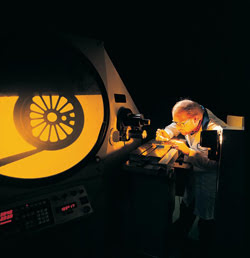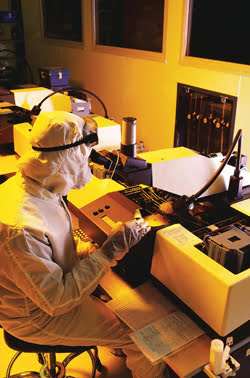Susan M. Reiss, Contributing Editor
Broadband access, including fiber to the premises, and technologies that cut capital and operational costs are key issues that will be discussed at the Optical Fiber Communications Conference (OFC 2004) on Feb. 22 through 27 at the Los Angeles Convention Center.
“Broadband access has been on the horizon for the last 15 to 20 years, but in the last year, things have heated up. All the technologies are there,” said Patrick Iannone, who is a technical program chairman of the conference. “There’s a lot of enthusiasm in the vendor community for this.”
With the first wave of broadband deployment under way based on digital subscriber line and cable modems, major service providers are beginning a second wave by leveraging the demand generated by existing infrastructure. They are adding video services such as high-definition television, video on demand and network-based personal video recorders to their portfolios, providing a significant boost to the deployment of fiber-to-the premises networks.
While many are eager to implement the technology for broadband access, “there’s still a question as to whether it makes sense from a business standpoint for widespread deployment,” Iannone said. The estimated cost to wire the US with fiber-to-the-premises technology is on the order of $100 billion, or approximately $1000 per household.
Large-scale deployments are already under way in East Asia. Japan and South Korea lead in fiber penetration for broadband access. At the OFC plenary session on Feb. 24, Yong-Kyung Lee, CEO of Korea Telecom Corp. in Seoul, will discuss the widespread availability and success of broadband access in Korea and the evolution of fiber in the loop to fiber to the home.
The session also will feature John P. Stenbit, assistant secretary of defense, networks and information integration and chief information officer for the US Department of Defense, and Bill Cadogan, a general partner of St. Paul Venture Capital. Stenbit will describe how and why the Pentagon chose dense wavelength division multiplexing (DWDM) as a networking solution. Cadogan will cover financial challenges facing carriers around the world and will detail specific issues that must be resolved to return the carriers to financial health.
A workshop dedicated to fiber-to-the-premises technologies will cover systems based on passive optical networks (PONs) that take advantage of a high-bandwidth, low-maintenance, unpowered outside plant; the distinctions between and the relative advantages/disadvantages of the various fiber-to-the-premises networks: asynchronous transfer mode PON, broadband PON and Ethernet PON; the roll-out plans of the current local exchange carriers; the technological challenges associated with delivering voice, video and high-speed data over this relatively unproven infrastructure; and the economic challenges associated with head-to-head facilities-based competition with existing cable operators.
OFC’s Market Watch will feature a session that will discuss moving from copper to fiber, broadband access in Japan and the paradoxes of broadband access.
Automation and integration
Now more than ever, the optical telecommunications industry is under pressure to reduce costs in all aspects of the business, from manufacturing to network monitoring. The technical sessions will reflect a maturing industry whose focus has become more pragmatic, according to the OFC technical chairmen.
 “The emphasis used to be primarily on increasing performance,” Iannone said. “It’s only been in the last several years since the downturn that the focus at OFC has shifted toward addressing costs.”
“The emphasis used to be primarily on increasing performance,” Iannone said. “It’s only been in the last several years since the downturn that the focus at OFC has shifted toward addressing costs.”
Driven by the need to reduce cost, network designers are focusing on testing and performance monitoring in multichannel DWDM systems. A number of papers will report on techniques to automate monitoring of networks. “If all-optical networks are to happen, we need to be able to monitor signals all along the line to get an indication of the health of the system,” Iannone said. Schemes to monitor faults, power and bit-error rates are essential.
Component integration continues to capture attention, and this year, researchers from the University of California and Agility Communications, both in Santa Barbara, will report on the first demonstration of a monolithic InP widely tunable transmitter. They integrated a sampled-grating distributed Bragg reflector laser with a semiconductor optical amplifier and a Mach-Zehnder modulator on a single InP substrate, extending the available bandwidth of optical modulators. They will report on increasing the 2-GHz modulation bandwidth by a factor of 10.
Researchers from NTT Photonics Laboratories have developed an electrical polarization mode dispersion equalizer integrated circuit using InP/InGaAs high-speed heterojunction bipolar transistor technology. The circuit reduces polarization mode dispersion, which causes signal distortion and limits transmission distances, and can compensate for differential group delay of more than 20 ps for a 40-Gb/s nonreturn-to-zero signal. Reducing or eliminating differential group delay lowers bit-error rates.
Novel network architectures are another important aspect of OFC 2004. In conventional wavelength-routed networks, a signal travels on a dedicated wavelength from one location to another. At times of low use, very few signals may travel on a wavelength. To access a portion of the dedicated wavelength, designers have developed optical burst switched networks, in which wavelength routes are used only as needed.
The challenge for designers is how to maximize throughput, minimize loss and control delay when many requests are sent simultaneously. Researchers from the Optical Networks Group at University College London offer a novel method to achieve this.
Beyond telecom
While key technologies continue to improve telecommunications systems, they also are finding applications in fields such as medicine and entertainment. Two OFC sessions will highlight the penetration of telecom light sources and devices into medical imaging and diagnostics. A new generation of rapidly swept laser sources developed for telecom and fiber Bragg grating sensing applications are contributing to a new generation of spectral domain optical coherence tomography systems that feature dramatically enhanced signal-to-noise ratios and, thus, much faster imaging rates than previous systems.
 Also, broad-spectrum sources that are based on semiconductor optical amplifiers, multiple quantum-well superluminescent diodes and photonic crystal fibers are displacing more expensive femtosecond laser systems in traditional optical coherence tomography systems. Clinical applications of this technology include ophthalmology and cancer detection in gastroenterology.
Also, broad-spectrum sources that are based on semiconductor optical amplifiers, multiple quantum-well superluminescent diodes and photonic crystal fibers are displacing more expensive femtosecond laser systems in traditional optical coherence tomography systems. Clinical applications of this technology include ophthalmology and cancer detection in gastroenterology.
In the area of diagnostics, the addition of frequency-doubling to the 980-nm semiconductor lasers used for erbium-doped fiber amplifiers is making it possible to miniaturize Raman spectrometers, which, until recently, required a large argon-ion laser as a source. Although not yet commercially available, the spectrometers would be about the size of two compact disc cases. High-volume production of 980-nm semiconductor lasers has also lowered their price tag. The lasers, which once cost about $10,000, now sell for less than $1000, according to Thomas Strasser, a technical program chairman.
The film industry relies on digital technology to produce movies and television shows. Yet the distribution of these products is done the old-fashioned way — via courier. With a national infrastructure based on optical networks in place, the industry is poised to begin transmitting films digitally and is discussing which standard transmission format to use.
“This is a good business case to drive next-generation networking technologies,” Strasser said. “The means to ship digital information is in place. What we needed was the newer equipment that now exists.” An example of new components that make digital signal transmission continuous is reconfigurable optical add/drop multiplexers that automatically switch light at the wavelength level. Without these components, signal routing and amplifiers had to be reset manually. Reuters News Service recently reported that Great Britain has committed $39 million to purchase digital movie screens and will have these in place by 2005. A report on digital cinema is featured at OFC.
This conference promises an expert view of the optical telecommunications industry from materials to business case studies. “The strength of OFC is that it offers discussions on the interdependence of all of these technologies,” Strasser said.